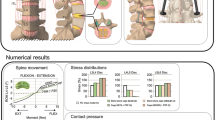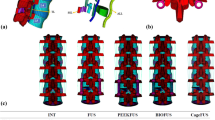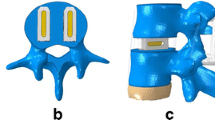Abstract
Intervertebral cages in the lumbar spine represent an advancement in spinal fusion to relieve low back pain. Different implant designs require different endplate preparations, but the question of to what extent preservation of the bony endplate might be necessary remains unanswered. In this study the effects of endplate properties and their distribution on stresses in a lumbar functional spinal unit were investigated using finite-element analyses. Three-dimensional finite-element models of L2-L3 with and without a cage were used. An anterior approach for a monobloc, box-shaped cage was modelled. The results showed that inserting a cage increased the maximum von Mises stress and changed the load distribution in the adjacent structures. A harder endplate led to increased concentration of the stress peaks and high stresses were propagated further into the vertebral body, into areas that would usually not experience such stresses. This may cause structural changes and provide an explanation for the damage occurring to the underlying bone, as well as for the subsequent subsidence of the cage. Stress distributions were similar for the two endplate preparation techniques of complete endplate preservation and partial endplate removal from the centre. It can be concluded that cages should be designed such that they rely on the strong peripheral part of the endplate for support and offer a large volume for the graft. Furthermore, the adjacent vertebrae should be assessed to ensure that they show sufficient density in the peripheral regions to tolerate the altered load transfer following cage insertion until an adequate adaptation to the new loading situation is produced by the remodelling process.






Similar content being viewed by others
References
Agazzi S, Reverdin A, May D (1999) Posterior lumbar interbody fusion with cages: an independant review of 71 cases. J Neurosurg 91:186–192
Antonacci MD, Hanson DS, Leblanc A, Heggeness MH (1997) Regional variations in vertebral bone density and trabecular architecture are influenced by osteoarthritic change and osteoporosis. Spine 22:2393–2401
Banse X, Devogelaer J, Munting E, Delloye C, Cornu O, Grynpas M (2001) Inhomogeneity of human vertebral cancellous bone: systematic density and structure patterns inside the vertebral body. Bone 28:563–571
Boden S, Sumner D (1995) Biologic factors affecting spinal fusion and bone regeneration. Spine 20:102S–112S
Brantigan JW, Steffee AD, Lewis M, Quinn L, Persenaire J (2000) Lumbar interbody fusion using the Brantigan I/F cage for posterior lumbar interbody fusion and the variable pedicle screw placement system: two-year results from a Food and Drug Administration investigational device exemption clinical trial. Spine 25:1437–1446
Closkey RF, Parsons JR, Lee CK, Blacksin MF, Zimmerman MC (1993) Mechanics of interbody spinal fusion. Analysis of critical bone graft area. Spine 18:1011–1015
Diedrich O, Perlick L, Schmitt O, Kraft CN (2001) Radiographic characteristics on conventional radiographs after posterior lumbar interbody fusion: comparative study between radiotranslucent and radiopaque cages. J Spinal Disord 14:522–532
Edwards WT, Zheng Y, Ferrara LA, Yuan HA (2001) Structural features and thickness of the vertebral cortex in the thoracolumbar spine. Spine 26:218–225
Frei H, Oxland TR, Rathonyi GC, Nolte LP (2001) The effect of nucleotomy on lumbar spine mechanics in compression and shear loading. Spine 26:2080–2089
Goel VK, Kong W, Han JS, Weinstein JN, Gilbertson LG (1993) A combined finite element and optimization investigation of lumbar spine mechanics with and without muscles. Spine 18:1531–1541
Grant J, Oxland T, Dvorak M (2001) Mapping the structural properties of the lumbosacral vertebral endplates. Spine 26:889–896
Hollowell J, Vollmer D, Wilson C, Pintar F, Yoganandan N (1996) Biomechanical analysis of thoracolumbar interbody constructs. How important is the endplate? Spine 21:1032–1036
Holmes A, Hukins D, Freemont A (1993) End-plate displacement during compression of lumbar vertebra-disc-vertebra segments and the mechanism of failure. Spine 18:128–135
Ikeuchi M, Yamamoto H, Shibata T, Otani M (2001) Mechanical augmentation of the vertebral body by calcium phosphate cement injection. J Orthop Sci 6:39–45
Jost B, Cripton P, Lund T, et al (1998) Compressive strength of interbody cages in the lumbar spine: the effect of cage shape, posterior instrumentation and bone density. Eur Spine J 7:132–141
Kettler A, Wilke H-J, Dietl R, Krammer M, Lumenta C, Claes L (2000) Stabilizing effect of posterior lumbar interbody fusion cages before and after cyclic loading. J Neurosurg 92:87–92
Kothari M, Keaveny TM, Lin JC, Newitt DC, Genant HK, Majumdar S (1998) Impact of spatial resolution on the prediction of trabecular architecture parameters. Bone 22:437–443
Kuslich S, Ulstrom C, Griffith S, Ahern J, Dowdle J (1998) The Bagby and Kuslich method of lumbar interbody fusion: history, techniques, and 2-year follow-up results of a united states prospective, multicenter trial. Spine 23:1267–1279
Kuslich S, Danielson G, Dowdle J, et al (2000) Four-year follow-up results of lumbar spine arthrodesis using the Bagby and Kuslich lumbar fusion cage. Spine 25:2656–2662
Lu M, Hutton WC (1996) Do bending, twisting, and diurnal fluid changes in the disc affect the propensity to prolapse? A viscoelastic finite element model. Spine 21:2570–2579
McAfee P (1999) Interbody fusion cages in reconstructive operations on the spine; current concepts review. J Bone Joint Surg Am 81:859–880
Millard J, Augat P, Link T, et al (1998) Power spectral analysis of vertebral trabecular bone structure from radiographs: orientation dependence and correlation with bone mineral density and mechanical properties. Calcif Tissue Int 63:482–489
Mosekilde L (1993) Vertebral structure and strength in vivo and in vitro. Calcif Tissue Int 53:S121–S125; (S126 discussion)
Mosekilde L, Mosekilde L, Danielsen CC (1987) Biomechanical competence of vertebral trabecular bone in relation to ash density and age in normal individuals. Bone 8:79–85
Mulholland R (2000) Cages: outcome and complications. Eur Spine J 9:S110–S113
Odgaard A (1997) Three-dimensional methods for quantification of cancellous bone architecture. Bone 20:315–328
Overaker D, Langrana NA, Cuitino A (1999) Finite element analysis of vertebral body mechanics with a nonlinear microstructural model for the trabecular core. J Biomech Eng 121:542–550
Pavlov P, Spruit M, Havinfa M, Anderson P, van Limbeek J, Jacobs W (2000) Anterior lumbar interbody fusion with threaded fusion cages and autologous bone grafts. Eur Spine J 9:224–229
Polikeit A, Ferguson S, Nolte LP, Orr T (2002) Factors influencing stresses in the lumbar spine after the insertion of intervertebral cages: finite element analysis. Eur Spine J DOI 10.1007/s00586-002-0505-8
Ray C (1997) Threaded titanium cages for lumbar interbody fusions. Spine 22:667–680
Roberts S, McCall I, Menage J, Haddaway M, Eisenstein S (1997) Does the thickness of the vertebral subchondral bone reflect the composition of the intervertebral disc? Eur Spine J 6:385–389
Shirazi-Adl SA, Shrivastava SC, Ahmed AM (1984) Stress analysis of the lumbar disc-body unit in compression. A three-dimensional nonlinear finite element study. Spine 9:120–134
Shirazi-Adl A, Ahmed AM, Shrivastava SC (1986) Mechanical response of a lumbar motion segment in axial torque alone and combined with compression. Spine 11:914–927
Silva MJ, Keaveny TM, Hayes WC (1997) Load sharing between the shell and centrum in the lumbar vertebral body. Spine 22:140–150
Steffen T, Tsantrizos A, Aebi M (2000) Effect of implant design and endplate preparation on the compressive strength of interbody fusion constructs. Spine 25:1077–1084
Steffen T, Tsantrizos A, Fruth I, Aebi M (2000) Cages: designs and concepts. Eur Spine J 9 [Suppl 1]:S89–S94
van Dieën J, Kingma I, Meijer R, Hänsel L, Huiskes R (2001) Stress distribution changes in bovine vertebrae just below the endplate after sustained loading. Clin Biomech 16:S135–S142
Wenger KH, Wilke H-J, Pross A, Claes LE (1997) Mechanical and ultrastructural properties of the osseous vertebral endplate. Annual report of the Institut für Unfallchirurgische Forschung und Biomechanik, Ulm
Wenger K, Pross A, Wilke H-J, Gossee F, Vahldiek M, Claes LE (1999) Bone mineral density of the vertebral endplate: an in vitro comparison of normals, degeneratives and osteoporotics. 26th Annual Meeting, ISSLS, Kona, Hawaii
Acknowledgements
The authors thank Dr. Qingmao Hu for assistance with the segmentation of the CT slices.
Author information
Authors and Affiliations
Corresponding author
Rights and permissions
About this article
Cite this article
Polikeit, A., Ferguson, S.J., Nolte, L.P. et al. The importance of the endplate for interbody cages in the lumbar spine. Eur Spine J 12, 556–561 (2003). https://doi.org/10.1007/s00586-003-0556-5
Received:
Revised:
Accepted:
Published:
Issue Date:
DOI: https://doi.org/10.1007/s00586-003-0556-5




